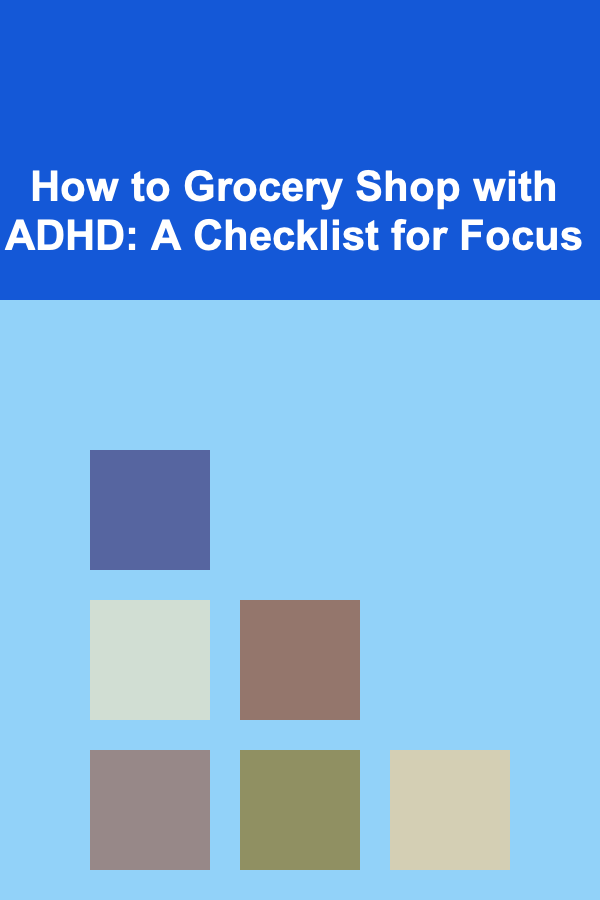
How to Grocery Shop with ADHD: A Checklist for Focus
ebook include PDF & Audio bundle (Micro Guide)
$12.99$5.99
Limited Time Offer! Order within the next:

Grocery shopping is a task many people take for granted --- it's something routine, often straightforward, and manageable. But for individuals with ADHD (Attention Deficit Hyperactivity Disorder), grocery shopping can quickly become overwhelming, frustrating, and mentally exhausting. The bright lights, endless aisles, myriad choices, and constant distractions present a unique challenge to maintaining focus, completing the shopping efficiently, and sticking to a budget.
ADHD affects executive functioning skills --- including organization, planning, impulse control, and attention regulation. These are exactly the skills grocery shopping demands. This means that grocery shopping for people with ADHD requires intentional strategies, preparation, and practical tools to stay on track.
This article explores in depth how to grocery shop with ADHD by offering a detailed checklist for focus, actionable tips, and insights into how ADHD influences the shopping experience. Whether you shop weekly or monthly, alone or with support, this guide aims to make the grocery store a less daunting and more manageable environment.
Understanding the Challenges of Grocery Shopping with ADHD
Before diving into practical strategies, it's important to understand why grocery shopping can be especially difficult for people with ADHD.
1. Sensory Overload
Grocery stores are sensory-rich environments. Bright fluorescent lights, loud announcements, music, crowds, and the smell of various foods all bombard the senses. For many with ADHD, this sensory input can lead to overwhelm, distraction, and difficulty maintaining focus on the task.
2. Decision Fatigue
Grocery stores offer thousands of choices. From dozens of brands of bread to multiple types of snacks, the number of decisions to make can create mental fatigue. This overload can cause impulsive buying or "paralysis by analysis" where shoppers freeze and struggle to choose.
3. Distractions and Impulse Buying
Colorful packaging, sales signs, and strategically placed products can tempt shoppers to deviate from their shopping list. Impulse control issues common with ADHD make it harder to resist these distractions, leading to buying unnecessary items.
4. Difficulty with Planning and Organization
Effective grocery shopping requires planning --- making lists, budgeting, meal planning --- and organizing the shopping trip logically. Challenges with executive function can disrupt this flow, making trips longer and less efficient.
5. Time Management
People with ADHD may struggle to estimate how long tasks will take or become hyperfocused on certain sections, leading to extended time in the store. This can result in fatigue, stress, or rushing at the end.
The Importance of Preparation: Setting the Stage for Focused Grocery Shopping
Preparation is the foundation for successful grocery shopping with ADHD. With the right pre-shopping routine, you can reduce anxiety, minimize distractions, and make the entire experience smoother.
Checklist for Pre-Shopping Preparation
- Schedule Your Shopping Trip During Optimal Times: Choose times when stores are less crowded and you feel most alert. For many, weekday mornings or early afternoons work best.
- Make a Detailed Grocery List: Write down what you need based on meals planned or essentials running low. Using apps that organize your list by category can help.
- Prepare Your Mindset: Practice mindfulness or brief meditation before shopping to calm nerves and improve focus.
- Set a Budget: Decide how much money you want to spend and stick to it by bringing only the necessary cash or card.
- Use Reminders: Set alarms or reminders on your phone for shopping time and to prompt list review.
- Choose Your Shopping Method: Decide whether you prefer in-store shopping or grocery delivery/pickup. Delivery can be a good option on overwhelming days.
- Gather Necessary Supplies: Bring reusable bags, coupons, a pen for list checking, and your phone for price comparisons or additional shopping apps.
Strategies for Staying Focused While Shopping
Once at the store, implementing focused strategies helps manage the ADHD challenges that arise in the moment.
Checklist for Focus During the Trip
- Stick to the List: Refer back to your list often and mark off items as you pick them. Use tactile engagement to reinforce memory.
- Shop in Sections: Organize your list by store sections and shop methodically to avoid backtracking and getting distracted.
- Limit Browsing Time: Avoid wandering or stopping at every aisle. Set a timer if needed to keep moving.
- Minimize Sensory Input: Wear noise-cancelling headphones or earbuds with calming music or white noise to reduce auditory distractions.
- Avoid Shopping When Hungry or Tired: Your impulse control is weaker when you're low on energy or hungry.
- Use a Buddy System: If possible, shop with a friend or family member who can help keep you accountable and focused.
- Practice Self-Compassion: Recognize that it's okay if the trip isn't perfect. Avoid self-criticism to reduce stress.
- Take Breaks if Needed: Step outside or find a quiet corner for a brief moment to reset your focus.
Practical Tools and Apps to Assist Shopping with ADHD
Leveraging technology can streamline grocery shopping and reduce cognitive load.
- Shopping List Apps: Apps like AnyList, Bring!, or Google Keep allow you to create organized, shareable lists with categories and reminders.
- Meal Planning Apps: Plan meals ahead and generate grocery lists automatically.
- Budget Tracking Apps: Tools like Mint or YNAB help track spending and keep you within budget.
- Barcode Scanners: Apps that scan products to check prices and nutritional info help avoid confusion or second-guessing.
- Store Maps: Some grocery stores have apps with floor plans to help plan your route through the aisles.
ADHD-Friendly Grocery Shopping Checklist: Step-by-Step Guide
Here's a comprehensive stepwise checklist you can print or save on your phone before your next grocery shopping trip:
Before Leaving Home
- [ ] Pick optimal shopping time based on your energy and store crowd patterns.
- [ ] Plan meals for the week ahead.
- [ ] Create a categorized grocery list (produce, dairy, meat, pantry, etc.).
- [ ] Set a spending budget.
- [ ] Check pantry and fridge to avoid buying duplicates.
- [ ] Prepare shopping bags, wallet, phone, and list.
- [ ] Do a quick mindfulness or breathing exercise.
At the Store
- [ ] Enter with a clear goal: stick to the list.
- [ ] Use headphones if sensory distractions are too strong.
- [ ] Shop by sections in order: produce → dairy → meat → frozen → pantry.
- [ ] Mark off items on the list as you collect them.
- [ ] Avoid impulse purchases by asking: "Do I really need this?"
- [ ] Take brief breaks if feeling overwhelmed.
- [ ] Keep track of spending as you go.
- [ ] Stay hydrated and take a snack break if hungry.
After Shopping
- [ ] Review receipts and compare to budget.
- [ ] Put groceries away immediately to avoid clutter.
- [ ] Reflect on what worked well and what didn't for next time.
Additional Tips for Managing ADHD During Grocery Shopping
Use Visual Reminders
Color-code your grocery list or highlight essentials. Visual cues can trigger memory and reduce overwhelm.
Limit Store Choice
Shopping at familiar stores reduces cognitive load since you know the layout and typical product placements.
Consider Grocery Delivery or Pickup
If shopping in-store is too challenging, many stores offer online ordering with delivery or curbside pickup options. This reduces sensory overload and saves time.
Practice Positive Reinforcement
Reward yourself after completing a shopping trip successfully --- this could be with a small treat, downtime, or doing something enjoyable.
Addressing Emotional Aspects of Grocery Shopping with ADHD
Grocery shopping can cause stress, anxiety, or feelings of failure for people with ADHD. It's important to address these emotional aspects:
- Acknowledge Your Struggles: ADHD is a neurological condition. Struggles are not personal shortcomings.
- Seek Support: Talk with family, friends, or ADHD support groups about your challenges.
- Celebrate Small Wins: Focus on progress, not perfection.
- Plan Self-Care: Incorporate relaxing activities before and after shopping to manage stress.
Case Study: Sarah's Story --- Applying the Checklist
Sarah, a 28-year-old woman diagnosed with ADHD, often found grocery shopping stressful and overwhelming. She frequently forgot items, overspent, and ended up exhausted.
After adopting the strategies in this article, Sarah:
- Shops in the morning when stores are quiet.
- Uses a meal planning app to create weekly lists.
- Wears noise-cancelling headphones with calm music.
- Takes a 5-minute mindfulness break halfway through the trip.
- Shops with a friend once a week for accountability.
- Uses curbside pickup on busy or stressful days.
This approach transformed her experience, making shopping manageable and less stressful.
Summary: Key Takeaways
- Preparation is crucial: meal plan, list, budget, and choose the right time.
- Stick to the list and shop systematically.
- Use tools like apps and headphones to reduce distractions.
- Practice self-compassion and manage sensory input.
- Consider alternatives like grocery delivery.
- Reflect and adjust strategies based on your unique needs.
Final Thoughts
Grocery shopping with ADHD doesn't have to be a source of anxiety or frustration. With intentional planning, mindful strategies, and the right tools, it can become a routine that fits your needs and reduces overwhelm.
Remember that ADHD affects everyone differently, so it's important to customize these suggestions to what works best for you. The ultimate goal is to create a system that helps you focus, saves time, and allows you to enjoy the process more.
By using this detailed checklist and embracing a patient, flexible mindset, grocery shopping can transform from a dreaded chore into a manageable and even empowering part of your week.
If you want, I can also provide printable versions of this checklist or personalized planning templates for your shopping trips! Would that be helpful?
Reading More From Our Other Websites
- [Small Business 101] How to Design an Eye‑Catching Window Display on a Shoestring Budget
- [Personal Care Tips 101] How to Apply Mascara for Sensitive Eyes
- [Home Cleaning 101] How to Declutter Your Digital Space: A Cleaning Guide
- [Home Party Planning 101] How to Use Lighting to Enhance Your Party Ambiance
- [Screen Printing Tip 101] Choosing the Perfect Screen Printing Frame: A Beginner's Guide
- [Personal Care Tips 101] How to Use Makeup Primer for Long-Lasting Makeup in Hot Weather
- [Survival Kit 101] Bushcraft Gear for Beginners: What You Need for Your First Wilderness Adventure
- [Personal Investment 101] How to Invest in Art: A Luxurious and Lucrative Investment Opportunity
- [Biking 101] Why Bike Helmets Are Essential for Every Ride: Safety Tips
- [Organization Tip 101] How to Use Vertical Space for Hanging Equipment

Creative Ways to Save Money on Home Cleaning Services and Keep Your Home Sparkling
Read More
How to Achieve a Scandinavian Design on a Budget
Read More
How to Choose the Right Lock for Your Home's Exterior Doors
Read More
Understanding Craft Beer Fermentation Basics: The Art and Science of Brewing
Read More
Baking for Special Occasions: A Comprehensive Guide
Read More
How to Create a Camping Checklist for Dispersed Camping
Read MoreOther Products

Creative Ways to Save Money on Home Cleaning Services and Keep Your Home Sparkling
Read More
How to Achieve a Scandinavian Design on a Budget
Read More
How to Choose the Right Lock for Your Home's Exterior Doors
Read More
Understanding Craft Beer Fermentation Basics: The Art and Science of Brewing
Read More
Baking for Special Occasions: A Comprehensive Guide
Read More